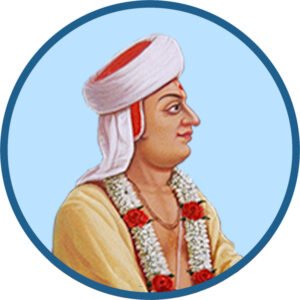
Lord Swaminarayan

On the day of Chaitra Sud 9, Vikram Samvat 1837, Lord Swaminarayan, incarnated on this planet to liberate countless souls in the pious village of Chhapaiya in northern India. At the time, society was troubled with social, moral and spiritual issues. Thus, Lord Swaminarayan was born to Dharmadev and Bhaktimata with the resolve to re-establish long-gone spirituality within humanity.
From his childhood, Ghanshyam (Lord Swaminarayan’s childhood name) was a role model for his peers and native villagers. At such a young age, He would regularly engage himself in worship and display His commitment to the values of dharma (good conduct), satya (truth), ahimsa (non-violence), and brahmacharya (celibacy). This made it clear that the Supreme Lord had Himself incarnated with qualities that surpassed human characteristics. Through many divine incidents and His divine qualities, Ghanshyam revealed His firm commitment to rekindle the extinguished fire of Dharma (Moral Principles), Gnan (Knowledge), Bhakti (Devotion) and Vairagya (Detachment).
After the demise of His parents, due to intense non-affection(dislike) for this world, at the age of 11, Ghanshyam left his home to travel the length and breadth of India to liberate all that came into His contact. Nilkanth’s (Lord Swaminarayan’s teenage name) barefoot travels spanned over 12,000 kilometers over the terrains of past India, perilous high peaks of the Himalayas, and the dense jungles where even sunlight was unable to pass through. During his travels, Nilkanth endured the extreme temperatures of the Himalayas and spent 4 months performing penance at Muktinath for the benefit of others. After transforming many lives through His travels, Nilkanth stopped His journey in the pious feet of a true saint named Shri Muktanand Swami.
After some time, Nilkanth was initiated and named Sahajanand Swami by Sadguru Shri Ramanand Swami and was passed on the leadership of the Uddhav Sampraday. Utilizing the theological principles present within Hindu Scriptures, Sahajanand Swami taught all that came into His contact about the liberation of one’s soul. Performing Bhakti of the Supreme Lord via the association of a “Sadhu” endowed with all the virtues of a true renunciant was one of the main principles He preached to all. More than 3000 saints were initiated by Lord Swaminarayan during His time. Lord Swaminarayan encouraged his Saints to travel from village to village preaching divine sermons and redirecting sinful lives towards piety.
In addition, Lord Swaminarayan was also very keen on selfless service and giving back to the community. He extinguished immoral practices such as “Sati-Pratha” (live widows burned to death during their husband’s cremation) prevalent within society at that time. During His time on Earth, He directed wells to be dug, set up welfare homes, and instructed donations to be provided to Brahmins and the meek. Under His own guidance, Shri Hari had 6 lavish temples erected over different areas of Gujarat. Alongside, He sanctified countless villages where he performed divine incidents and narrated spiritual sermons which have been compiled into an exceptional scripture known as the “Vachanamrut”. With His own hands, Lord Shree Swaminarayan compiled the Shikshapatri – a scripture consisting of 212 verses which lays out the rules to be followed by the followers of the Swaminarayan sect. Furthermore, on the solemn day of Jeth Sud 10, Vikram Samvat 1886, Lord Swaminarayan departed from this earth but He forever remains omni-present and dwells in the hearts of His utmost dear devotees.
3 April 1781 – Incarnates as Ghanshyam in Chhapaiya.
12 July 1781 – Markandeya Muni Names Lord – Hari, Krishna, and Hari-Krishna
31 March 1786 – Begins the study of Sanskrit.
5 February 1789 – Yagnopavit Ceremony Performed
29 June 1792 – Leaves home to begin Kalyan Yatra.
1793 – Performs four months of severe penance in Muktinath.
21 August 1799 – Arrives in Loj, meets Muktananad Swami.
18 June 1800 – Meets Ramanand Swami in Piplana
28 October 1800 – Initiated by Ramanand Swami as Sahjanand Swami and Narayan Muni.
16 November 1801 – Appointed as head of the fellowship.
31 December 1801 – Reveals the Swaminarayan mantra.
5 November 1802 – Muktanand Swami composes the Aarti
21 November 1819 – Begins the discourses recorded in the Vachanamrut.
12 February 1826 – The Shikshapatri is written in Vadtal.
1 June 1830 – Returns to Akshardham while in Gadhada.
Lord Swaminarayan

Life of Shree Ramanand Swami (1738 – 1801)
Early Life
Shree Ramanand Swami was born in 1738 CE in Ujjain, Madhya Pradesh, India. From childhood, he was deeply inclined towards spirituality and devotion to God. His natural humility, compassion, and detachment from worldly pleasures made him stand out even at a young age.
Spiritual Journey
In search of true knowledge, Ramanand Swami became a disciple of Ramanujacharya’s tradition of Vaishnavism. He followed the principles of devotion to Lord Narayan and dedicated his life to spreading dharma (righteousness) and bhakti (devotion).
Through his travels, he guided thousands of people in Gujarat and Saurashtra, teaching them values of non-violence, morality, seva (service), and devotion to God.
Establishing the Uddhav Sampraday
Ramanand Swami founded the Uddhav Sampraday, a fellowship of devotees who followed Vaishnav principles. His mission was to revive spirituality in an age when society was burdened by superstition and immorality. He established satsangs (spiritual gatherings) where people of all castes and backgrounds could come together for worship and learning.
Meeting Nilkanth Varni (Sahajanand Swami)
During his travels, Nilkanth Varni (the young Bhagwan Swaminarayan) was searching for a true Guru who practiced what he preached. In Piplana, Gujarat, Nilkanth Varni met Muktanand Swami (a senior disciple of Ramanand Swami), who later introduced him to Ramanand Swami.
Recognizing His divine virtues, Ramanand Swami initiated Nilkanth Varni into the Sanyas Ashram and gave Him the name Sahajanand Swami.
Spiritual Succession
In 1801 CE (VS 1858, Kartik Sud 11 – Prabodhini Ekadashi), before his departure from this world, Ramanand Swami appointed Sahajanand Swami as his successor and entrusted him with the leadership of the Uddhav Sampraday. With this divine act, the foundation of the Swaminarayan Sampraday was laid.
Departure
Soon after, in Faneni village (near Rajkot, Gujarat), Ramanand Swami left his mortal body and merged into the divine abode of Akshardham.
Legacy
Ramanand Swami was the Guru of Bhagwan Swaminarayan.
He revived spirituality in Gujarat and uplifted countless lives through satsang.
His humility and compassion set the foundation of the Swaminarayan Sampraday.
By appointing Sahajanand Swami as his successor, he fulfilled God’s divine plan.
Shree Ramanand Swami is forever remembered as the guiding light who prepared the path for Bhagwan Swaminarayan to establish eternal dharma and devotion in the world.
